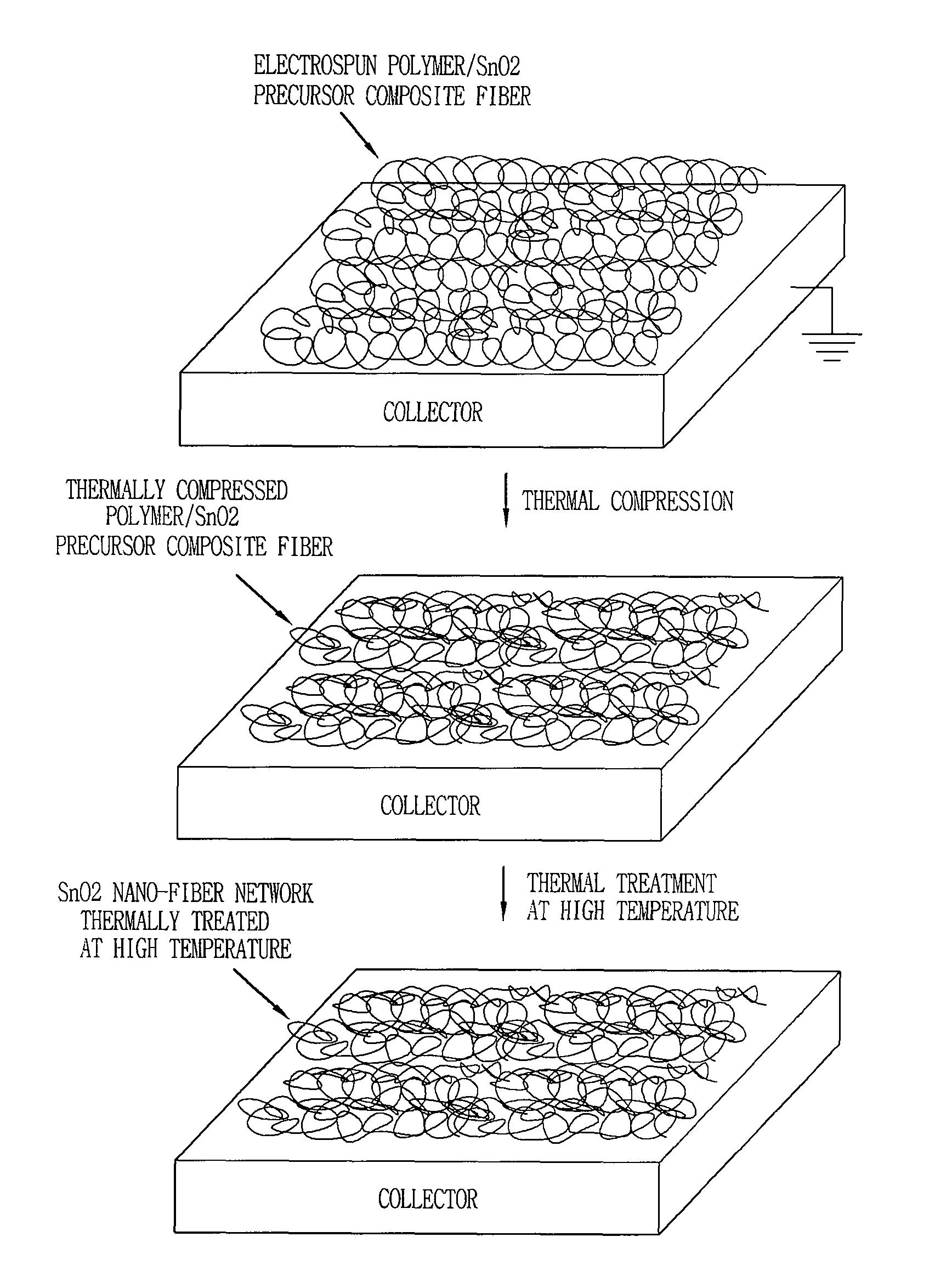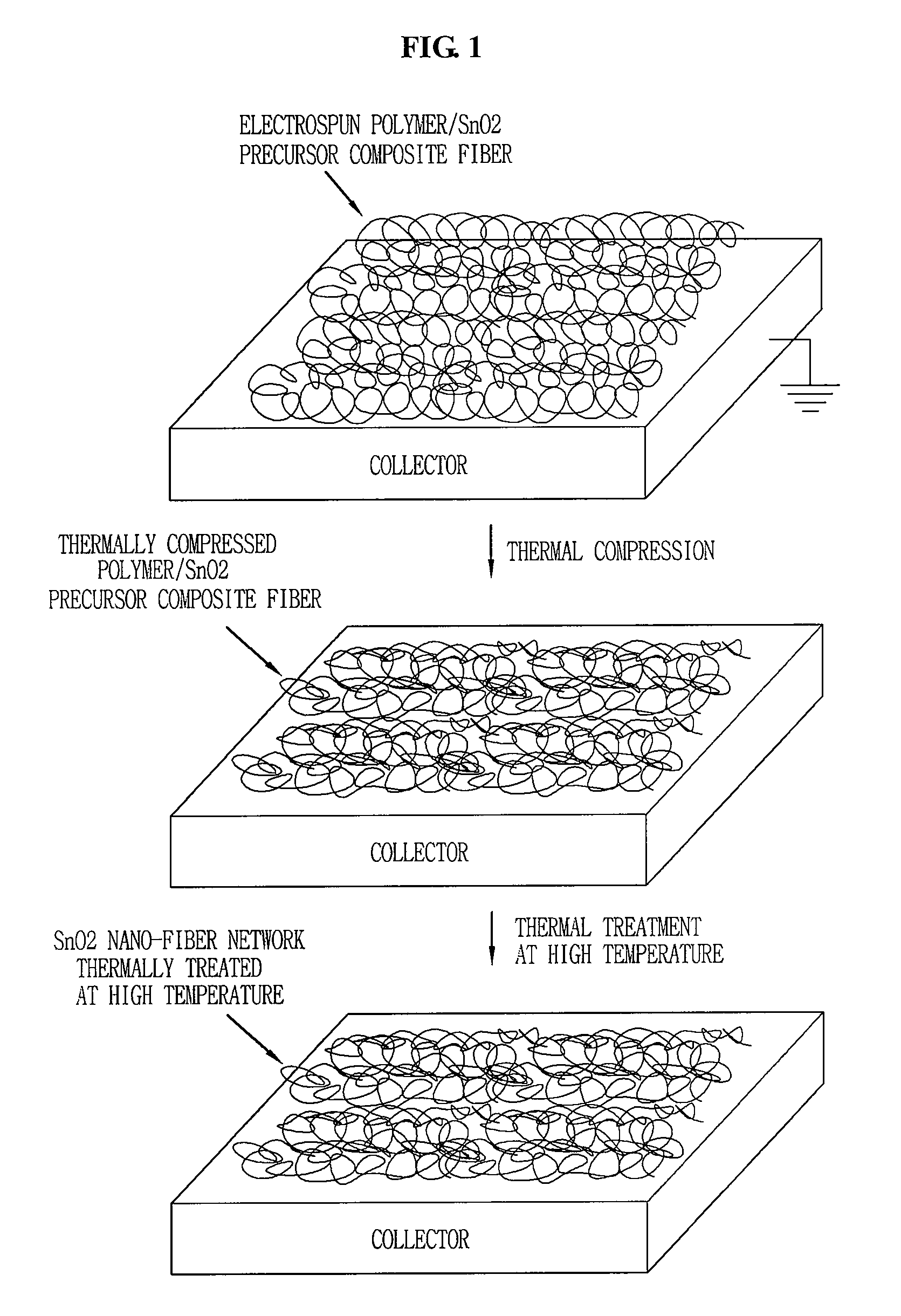Anode for secondary battery having negative active material with nano-fiber network structure and secondary battery using the same, and fabrication method of negative active material for secondary battery
a technology of nanofiber network structure and secondary battery, which is applied in the direction of electrode rolling/calendering, textiles and papermaking, and manufacturing processes of electrodes, etc., can solve the problems of limiting the theoretical maximum capacity to 372 mah, limiting an increase in its capacity, and affecting the stability of the battery. , to achieve the effect of high power, high cycling characteristics, and high speed charging/discharging
- Summary
- Abstract
- Description
- Claims
- Application Information
AI Technical Summary
Benefits of technology
Problems solved by technology
Method used
Image
Examples
example 1
Fabrication of an SnO2 Nano-fiber Network Structure Through Thermocompression and Post-heating Treatment of an SnO2-polyvinyl Acetate Composite Fiber Layer
[0067]A polymer solution obtained by dissolving 2.4 g of polyvinyl acetate (Mw: 1,000,000) in 15 ml of dimethylformamide for one day was mixed with a solution obtained by dissolving 6 g of tin acetate in 15 ml of dimethylformamide (DMF). Here, the solution was transparent and slightly yellowish. Since tin acetate is easily dissolved in DMF, a reaction occurred well without additionally using acetic acid for catalysis.
[0068]The transparent precursor in which the reaction had occurred was transferred into a syringe and mounted on the electrospinning device. Then, a voltage was applied between the tip provided at the end of the syringe and a collector to obtain an SnO2-polyvinylacetate composite fiber layer (see FIG. 3). In this case, the voltage was 12 kv, the flow rate was 30 μl / min, the total discharge amount was 500 to 5,000 μl, ...
experimental results 1
Evaluation of Characteristics of a Lithium Secondary Battery Using an SnO2 Nano-fiber Network as a Negative Active Material
[0070]To identify the characteristics of the SnO2 nano-fiber network formed on a stainless steel substrate according to Example 1 as a negative active material, a coin cell (CR2032-type coin cell) structure was fabricated as described below. In the cell structure, an EC / DEC (1 / 1 volume %) solution in which 1M of LiPF6 was dissolved was used as an electrolyte. For a cathode to be used as a reference electrode and a counter electrode, a metal lithium foil (Foote Mineral Co.) of a degree of purity of 99% was used. For a working electrode, an SnO2 nano-fiber network thin layer as obtained in Example 1 was used. As a separator for preventing electrical shorting between the cathode and anode, a polypropylene film (Celgard Inc.) was used. Such cell was fabricated under an Ar atmosphere in a glove box made by VAC Co., Ltd.
[0071]The experimental equipment used here for c...
example 2
Fabrication of an Fe2O3 Nano-fiber Network Through Thermocompression and Post-heating Treatment of an Fe2O3-polyvinyl Alcohol Composite Fiber Layer
[0075]2.5 g of polyvinyl alcohol (PVA, Mw: 88,000) was dissolved by stirring into 20 g of DI water for one day with heat. The PVA solution was mixed with a solution obtained by dissolving 5 g of anhydrous FeCl3 in 15 g of DI water. A transparent deep green solution could be obtained after stirring for several minutes. Then, 2 g of acetic acid and 0.05 g of Cetyltrimethylammonium bromide (CTAB) were added therein and stirred for several minutes. Here, CTAB serves as an additive for facilitating electrospinning by controlling electric charge characteristics of the metal oxide precursor.
[0076]After such prepared solution was transferred into a syringe and electrospun, a light green PVA-FeCl3 organic / inorganic composite fiber could be obtained (applied voltage: 14 kV, flow rate: 10 μl / min, amount of fabricated fiber: 500 μl, substrate: SUS, d...
PUM
| Property | Measurement | Unit |
|---|---|---|
| size | aaaaa | aaaaa |
| size | aaaaa | aaaaa |
| size | aaaaa | aaaaa |
Abstract
Description
Claims
Application Information
 Login to View More
Login to View More - R&D
- Intellectual Property
- Life Sciences
- Materials
- Tech Scout
- Unparalleled Data Quality
- Higher Quality Content
- 60% Fewer Hallucinations
Browse by: Latest US Patents, China's latest patents, Technical Efficacy Thesaurus, Application Domain, Technology Topic, Popular Technical Reports.
© 2025 PatSnap. All rights reserved.Legal|Privacy policy|Modern Slavery Act Transparency Statement|Sitemap|About US| Contact US: help@patsnap.com



